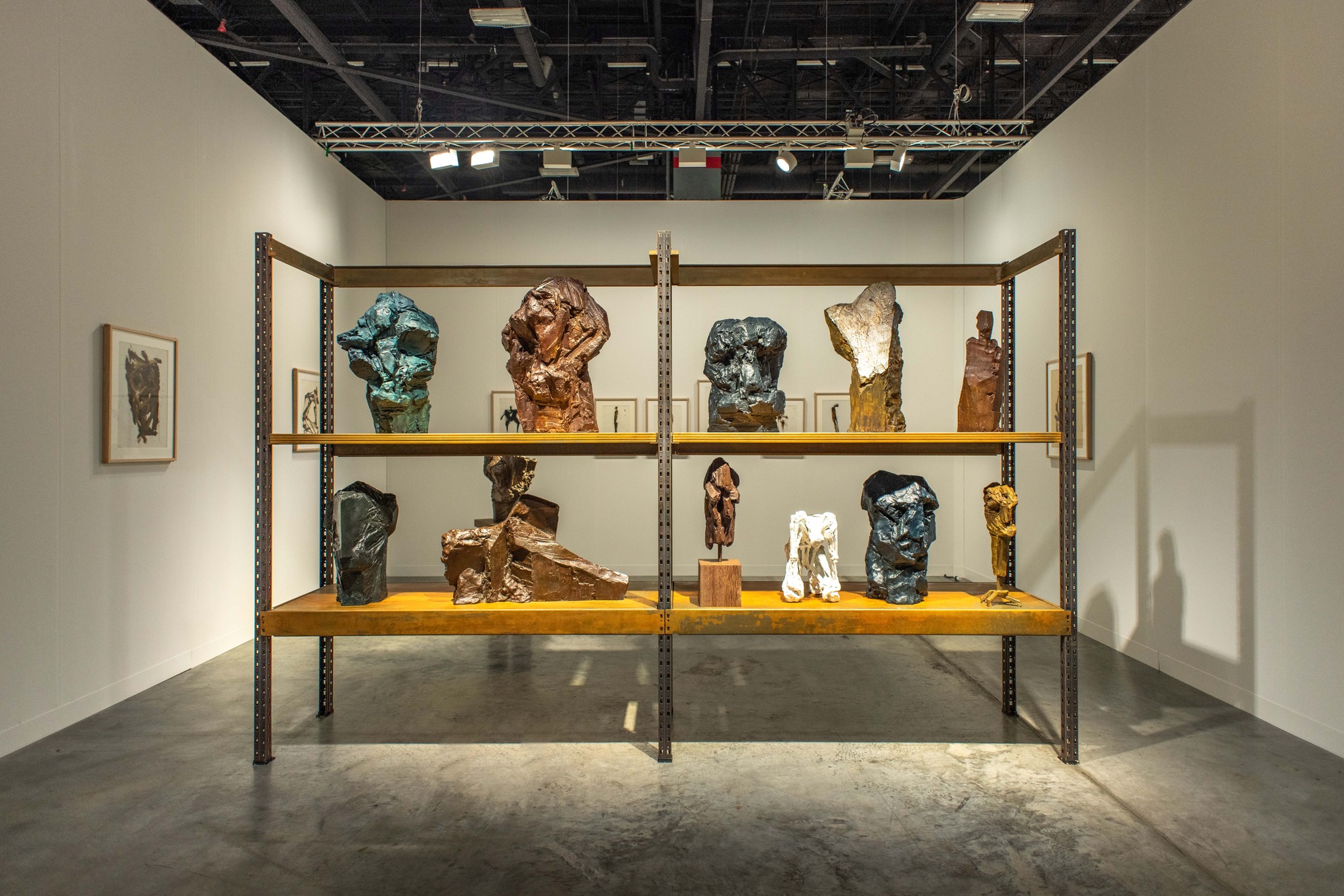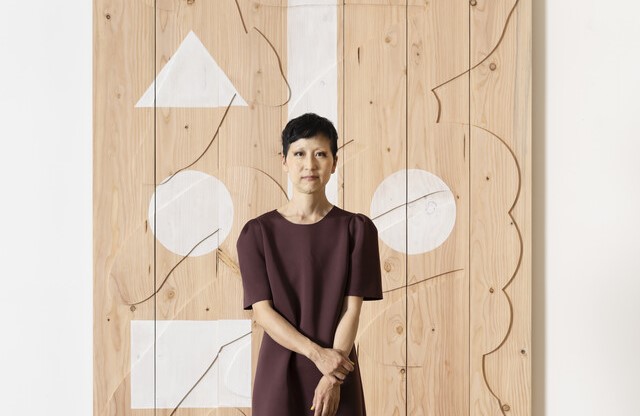Artist Hong Seung-Hye (b. 1959) has
experimented with a variety of media, including painting, collage,
installation, sculpture, graphics, and animation, to expand her artistic
practice. In particular, Hong combines, disassembles, and accumulates
rectangular pixels, a basic unit of digital imagery, to create proliferating
forms that are organic and dynamic. These images go through a number of formal
transformations as they move out of the computer monitor into everyday spaces,
expanding to flat and sculptural forms, animation, design, and architecture.
As such, with a sustained interest in
abstraction-as-spatial construction, Hong explores the relationship between the
work’s inner structure and the architectural space where it manifests a reality
where geometric abstraction comes to life.
 Hong Seung-Hye, Untitled,
1996 ©Sungkok Art Museum
Hong Seung-Hye, Untitled,
1996 ©Sungkok Art MuseumWhile
studying in France, Hong studied under Olivier Debré, who works in French Art
Informel, and became interested in the physical conditions and points that make
up a painting rather than representation the outside world. In the early 90s,
the artist was influenced by the Support-Surface group, a group that completely
dismantled the canvas and used it as a physical support, and began to make
collage works using paper.
Starting
with collage works in which she cut and crumpled paper and manipulated the
canvas freely, in her 1995 solo exhibition at the Kukje Gallery, she borrowed a
ready-made mold to cut and paint hardboard paper and then collaged it.

“Organic Geometry” Installation view ©Kukje Gallery
In 1997, at a time when all
information was computerized, the artist began using computers to create her
work. At first, she used the basic program Microsoft Paint to create shapes,
and then she used the program Photoshop to create patterns. For her, the
monitor screen is like a giant natural system. The process of pixels coming
together to form shapes is similar to the sprouting and growth of life in the
natural world.
The Organic Geometry series
also originated from this view of pixels as cells. Beginning with her solo
exhibition “Organic Geometry” at the Kukje Gallery in 1997, Hong Seung-Hye has
been deeply interested in the operation of physical space based on the
construction of computer pixels.
Starting from the idea of “What if the
shapes in the frame come out of the frame?”, the artist created shaped canvases
in the form of reliefs using aluminum panels, in which the shapes become a
single body and are attached to the wall, or works in which the artist sees
tiles as an extension of pixels and spatially expands them by attaching tiles
with transferred shapes to the wall or floor.
The artist describes her work as
“organic geometry”. In fact, the words that make up the title, “organic” and
“geometry,” are contradictory. 'Organic' is natural and uncertain, while
'geometry' is mechanical and stable. Hong explains that she finds artistic
meaning in embracing the two extremes of these contradictions and using the
unexpected conditions she encounters as rules for building her own “ideal
world.”
 Hong Seung-Hye, Debris,
2008 ©MMCA
Hong Seung-Hye, Debris,
2008 ©MMCAIn the process of deconstructing the
existing shapes, Hong witnesses how the shapes, like amoebas, come back to life
after being cut. Debris (2008), a work that began at this time, reflects
the artist's view that unexpected forms are created when images that she
thought were already completed are deconstructed, and that the resulting forms
become the starting point for creating new forms.
For example, some of the aluminum
panel works she has made in the past are cut into thin slices and recreated on
one side of an aluminum pipe, which she displays as the actual material. This
is an organic way of working, in which the finished work is transformed into a
material for further work, infinitely recombined in different ways, and
displayed anew. For example, in order to express that the results are not
fixed, the work Debris was installed and exhibited differently each time
in the past exhibition at the National Museum of Modern and Contemporary Art,
Gwacheon.

“Square Square” Installation view ©Atelier Hermès
Since then, Hong has expanded her work into
a more spatial realm. In 2003, Hong exhibited Organic Geometry as a
public installation in the lobby of the Gangnam Kyobo Tower, designed by
architect Mario Botta. Considering the sculptural context of the building, the
artist harmonized her work with the symmetrical structure of the building by
installing it in a symmetrical form.
In her solo exhibition “Square Square” at
the Atelier Hermès in 2012, the artist transformed the exhibition space into a
square, taking into account the sculptural characteristics of the building
itself. Hong came up with the word “Square Square” when she saw the cube-like
structure of the Atelier Hermès building.
'Square' means both a quadrangle and a
plaza, but the artist focused more on the meaning of a plaza. In response, the
artist interpreted the meaning of ‘quadrangle square’ as an element of ‘plaza
square’ or ‘quadrangle as a plaza’ in a form that can be coordinated with the
audience's daily movements, such as placing works where people can sit and
rest, or making the floor like a sidewalk block so that they can cross.
 “My Garage Band”
Installation view ©Space Willing N
Dealing
“My Garage Band”
Installation view ©Space Willing N
DealingHong
further developed her shapes into animations and began working on the ‘Dancing
Geometry’ series. She found that music was an essential element in bringing
movement to her shapes, so she chose songs that she listens to and had her
shapes dance to them. The songs Hong chose happened to be in the sad minor key,
which inspired her to name the series ‘The Sentimental.’
The
Sentimental series, which consists of nine works in
total, is based on pre-existing music, and later, using Apple's software
program Garage Band, the artist created dancing geometries based on her own
compositions. In her solo exhibition “My Garage Band” at Space Willing N
Dealing in 2016, Hong presented a video show in which a band composed of
Photoshopped human pictograms moved in Flash animation to a soundtrack created
by the artist.
In this
way, Hong's organic geometries are constantly assembled, deconstructed, and
multiplied through constant experimentation with the medium. In her solo
exhibition at Kukje Gallery last year, she presented a new work in which she
used the opportunity of the exhibition to learn Adobe Illustrator to create a
work of practice. Hong's grid-based works are now freed from the confines of
pixels, freely crossing over various media, disappearing, and reassembling in
an organic process. Furthermore, the artist has continued to intervene in our
reality beyond the frame.
“I expect art to make life more interesting than art, and as an artist, I want to play that role.” (National Museum of Modern and Contemporary Art Korea, MMCA Artist Talk | Hong Seung-Hye, 2021)

Artist Hong Seung-Hye ©Kukje Gallery
Born in
Seoul in 1959, Hong Seung-Hye studied fine art at Seoul National University,
receiving her B.F.A. in 1982. She went on to attend Ecole Nationale Supérieure
des Beaux-Arts in Paris, graduating in 1986. Since then, Hong has held more
than thirty solo exhibitions at various institutions including Kukje Gallery,
Atelier Hermès, SeMA Buk-Seoul Museum of Art.
She
participated in numerous shows both in Korea and abroad, including Gwangju,
Busan, and the Seoul Mediacity Biennale, as well as major group exhibitions at
the National Museum of Modern and Contemporary Art Korea, Seoul Museum of Art,
Ilmin Museum of Art, Korean Cultural Center in Paris, and The Museum of Modern
Art of Bologna. The recipient of the Total Art Award (1997) and the Lee
Jungseop Award (2007), Hong’s works are part of the collection of the National
Museum of Modern and Contemporary Art, Seoul Museum of Art, Leeum Museum of
Art, Sungkok Art Museum, and Art Sonje Center.



















